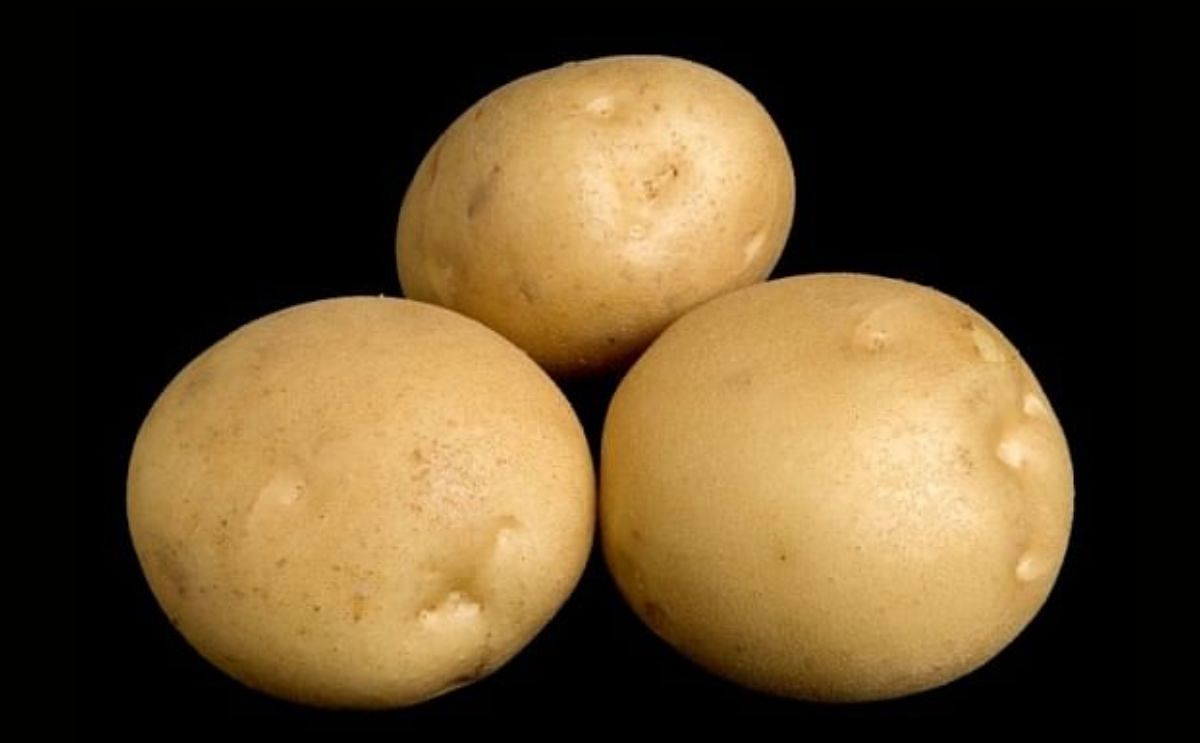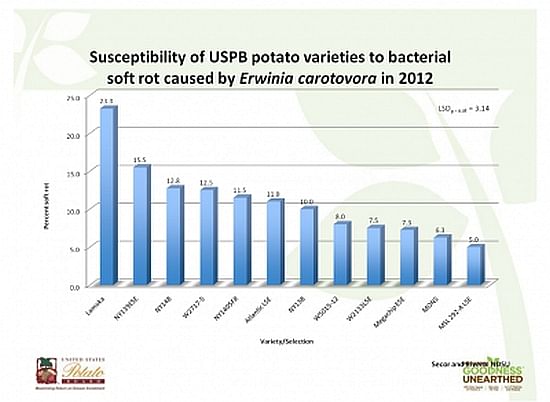The potato variety Lamoka
Update for Growers of Lamoka - Management Practices for Controlling Black Leg

Growers of the potato variety Lamoka used for chip processing have seen a higher than normal incidence of blackleg in their fields this summer. It is not completely clear why the incidence is higher than in previous years, however, it is something every grower should be aware of and manage accordingly.
Sometimes blackleg can be a prior warning of soft rot decay during storage. In the graph below, Dr. Gary Secor at North Dakota State University (NDSU) showed more decay in Lamoka tubers from the 2012 crop when challenged with the soft rot bacteria (Erwinia carotovora) than other selections and varieties. The same pathogen challenges on tubers from the 2013 crop did not show Lamoka as more susceptible than other chip varieties at NDSU and the University of Wisconsin.

Susceptibility of USPB potato varieties to bacterial soft rot caused by Erwinia carotovora in 2012
The chip industry has invested in Lamoka as a high-quality, late storage potato, and it is vital growers are aware of the variety’s characteristics observed so proper care can be taken when growing this variety. In other areas, Lamoka has shown less decay from late blight, pink rot and fusarium dry rot than Snowden in challenges at NDSU and the University of Wisconsin. The storage chip industry has worked with soft rot susceptible varieties such as Chipeta, Monona and other varieties for many years with great success. There are always some soft rot bacteria in the lenticels of any field grown potatoes, and if growers are seeing black leg in the field, there will probably be more bacteria in the lenticels and an increased soft rot potential.
If the environment around the tubers is perfect, no free water and cool temperatures, then bacterial soft rot will not develop because this bacterium grows very slow if plenty of oxygen is available. It can spread very rapidly if oxygen levels become low from excess water or slime from decay by other diseases like Pink Rot.
Past learnings to manage bacterial soft rot:
- Use all the best management practices during harvest to reduce bruise and pythium leak. Harvest only when pulp temperatures are below 65 degrees F. Put the fields with the lowest disease indications in the storages destined for late shipments. Maintain 95% relative humidity (RH) WITHOUT FREE WATER. Manage condensation drip.
- Storage tubers need lots of oxygen, cool temperatures (healing temperature 55 degrees F), and 95% RH to quickly produce waxy suberin and to grow a wound periderm.
- Cool the chip storage to the final holding temperature as soon as the sugar levels are stable and the sweat period is over. In research samples, Lamoka has been held at 45 degrees F. This is not recommended on a commercial level until it can be demonstrated that chip color and sugars can remain stable in large bins. Most commercial chip growers have stored Lamoka at a final holding temperature of 48 degrees.
- The University of Wisconsin has demonstrated how STEM END CHIP DEFECTS or SUGAR ENDS do not recondition any better at warmer holding temperatures than at cooler temperatures. The lower the storage temperature, the slower the bacteria will grow.
Seed management suggestions for next year:
(These are generally considered good practices for all seed applications)
- Look at your seed source fields before vine kill to choose the lowest risk seed lots.
- Minimize cutting by using seed lots that are mostly single drop and splitters. Seed piece decay is always much higher in four or six piece seed. Work with your seed growers to achieve this. Growing small size seed of Lamoka is difficult because tuber numbers per plant are low.
- Use extra sanitation practices during the cleaning of seed cutters, trucks, storages and other equipment. Power wash with hot water and soap to remove all dirt and slime, and then keep all surfaces wet with a disinfectant for ten minutes.
- Warm the seed before cutting. Heal all Lamoka seed two weeks at 50 degrees F after cutting with a lot of air flow before planting.
- Seed sprouts smear bacteria on other tubers when crushed, so work with your seed grower to keep your seed lots dormant.
- Avoid bruising seed and potatoes for storage during handling and transport. This is the number one cause of soft rot decay because soft rot bacteria require a wound to enter. Excessive bruising results in potatoes with a high soft rot potential.
- Manage fusarium dry rot. Fusarium also requires a wound to infect, and the soft rot bacteria can colonize fusarium infections and start soft rot decay. Controlling fusarium dry rot indirectly helps manage soft rot decay.
- There are no chemicals to manage soft rot once infection has occurred. Prevention is the best management tool.










